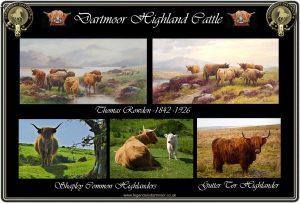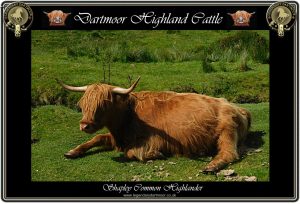
You are driving over the B3212 road by Shapley Common, its a crisp autumn day, the heather is in full bloom casting a purple hue over the hazy moorland and all of a sudden in the middle of the road you see a shaggy looking cow. Somewhere beneath its furry sporran-like forelock two eyes stare out through the large handlebar horns, hang on, moorland, heather and a Highland Cow, is this Dartmoor or Scotland? No this is definitely Dartmoor and what is defiantly staring at you is one of the latest cattle breeds to be introduced onto the moor, well I say latest but the breed has been roaming the moorland for quite a few years now thanks to the work of a few selective breeders.
The painting below of Highland Cattle on Belstone Tor was the work of Thomas Rowden a well known Dartmoor artist who specialised in landscapes featuring the cattle and ponies on the moor. Virtually all of his Dartmoor work was done sometime between 1880 and 1926, therefore in theory this painting must suggest that Highland Cattle were being stocked upon Dartmoor during that period. It has been suggested that these Highland Cattle were first introduced into the Belstone area by William Symington who farmed at East Okement farm in the 1880s which would tie in nicely with Rowden’s work. More precise dating evidence comes from the description of a Dartmoor walk in 1880; “We descended the south-east side of the Moor into the valley of the West Okement stream, one of the most secluded and lonely on the moor, and here in many large patches the pasturage is rich, and the ground very easy to walk upon. We came upon a large herd of very ‘mixed’ cattle, which are normally turned out upon the Moor between May and September. There were a few of our own beautiful Devons, three rather poor looking Jerseys, and a great number of those wild and picturesque looking, shaggy, long-horned Highland Cattle… They have recently been tried on the moor as an experiment, and, judging from their splendid appearance, we doubt not but that the enterprising farmer will be well rewarded.” The Exeter & Plymouth Gazette, June 8th, 1880. The chances are that the writer encountered Mr. Symington’s animals whose farm would have been about two and a half miles away to the east of the valley. Talking of which – On the 12th of June 1885 the Devon & Exeter Gazette published the following report: “On Tuesday Mr. W. Fewins held a sale near the Okehampton Station for a portion of the herd Highland Cattle, lately established by Mr. W. W. Symington of Belstone, at his moorland farm, Hart Tor, on Dartmoor. There was a very large attendance, and the sale caused quite an excitement. The competition was spirited and so were the animals. Over 200 were brought under the hammer, and every lot sold… Mr. Roger Palmer became the purchaser of that celebrated pedigree bull ‘Rory Og’ for his Meldon Herd, and Mr. Luscombe, South Devon, of ‘Tormaid Og‘.” This then drills down the date to at least before 1885 when the animals were introduced to Dartmoor. It also shows the surprisingly large size of the herd if a portion of Symington’s herd was 200, additionally it also indicates that another farmer at Meldon was also keeping Highland Cattle. In 1886 at Okehampton March Fair a herd belonging to M. Lamb of Princetown was sold. The lot consisted of five three-year old steers, ten cows in calf, six heifers and one barrener with the lot averaging at £8 a piece.
There are also a couple of photographs on the Dartmoor Archive website of Highland Cattle around Taw Marsh which were taken by G. St. Leger-Gordon in 1941.
It has been suggested in a recent study that Highland Cattle are descendants from the prehistoric Aurochs which became extinct around 6,750 years ago. Auroch bones have been discovered around the Torquay area in a submerged forest so who knows, did they ever venture north as far as Dartmoor? If they did then the ‘Highlanders’ we see today may well be their direct descendants?Scientists in Dublin have managed to extract genetic material from an auroch’s bone which was found in a Derbyshire cave. The team reported that; “Unearthing the genetic blueprint of aurochs, the team of researchers compared the genome to the genomes of two major groups of cattle already known to have been descended from the aurochs, and DNA marker information from more than 1,200 modern cows. The team discovered clear evidence of breeding between wild British aurochs and early domesticated cattle such as Highland Cattle. David MacHugh, senior author on the study from the School of Agriculture and Food Science at YCD, said: “Our results show the ancestors of modern British and Irish breeds share more genetic similarities with this ancient specimen than other European cattle. This suggests that early British farmers may have restocked their domesticated herds with wild aurochs.” – The National, October 28th, 2015. Just as an interesting aside and on the subject of aurochs here, back in 2005 a farmer from Broadwoodwidger which is about 13 miles from Okehampton introduced a herd of cows that had been purposefully been back bred to the auroch known as Heck Cattle. Unfortunately most of the animals were too aggressive to handle and had to be disposed of which considering their huge, very pointy and extremely sharp horns probably was a good idea.
The ideal terrain where Highland cattle can breed and thrive consists of wide expanses of moorland with a cold and wet climate – in other words Dartmoor. The breed has the innate ability to efficiently convert the rough moorland vegetation. The distinctive handle-bar horns of Highland Cattle allow them to forage in wintry conditions by using them to rake into the snow thus exposing the vegetation underneath They are noted as being a hardy breed and are quite comfortable with calving outdoors and coping with the winter weather which in theory means there is no need to house them during the winter months. Their coat consists of two layers, the outer layer is high in natural oils and so prevents rainwater seeping into their skin whilst the inner layer is more downy and acts as a winter insulator. The very fact that their thick coats retain heat as opposed to it being done by storing excess fat means that the meat in quite lean. In addition to their coat they are famous for having a hairy forelock (known as ‘bangs’) and eye lashes which protect the eyes from flies etc. and the infections they can cause. A little known fact is that groups of Highland Cattle are not called herds but are known as ‘folds’ this is because in the highlands the animals would have been penned in open stone shelters (known as folds) overnight to protect them from the weather and wolves. Because the Dartmoor ‘folds’ graze on the moorland grass and fodder it means that their meat is much tastier than grain fed animals. This is because natural grasses and fodder contain a lower concentration of fatty acids which can change the fatty acid, oxidative stability and flavour of the meat. Studies have shown that their beef is approximately 38% lower in fat and 4% lower in cholesterol than other beef breeds and additionally it is accepted that the meat is also higher in protein and iron. As a breed they are not the largest of cattle with bulls weighing around 800 kg. and cows 500 kg. The females make excellent mothers and due to their long life expectancy (over 18 years) can easily produce 15 calves. The cows are easy unassisted calvers due to having a wide pelvis and the moderate bone structure and slim confirmation of the calf which can weigh between 20 and 35 kilograms. Highland Cattle are normally a quite and placid breed despite their fearsome looks, however, as with all cattle the mothers will protect their young calves if threatened.
There have been several posts on Social Media asking where they can see the ‘Highlander’ roaming free on Dartmoor and according to the Highland Cattle Society there are two breeders on Dartmoor, one near North Bovey and the other one at Trowlesworthy. Good locations to see the cattle are anywhere along the B3212 around the Shapley Common and Bushdown area and the Trowlesworthy/Ditsworthy/Brisworthy area.
As with all of Dartmoor’s livestock which graze on the open moor they are at risk from speeding motorists hence the 40 mph speed limit. This is especially so in the winter months for several reasons; it’s darker for longer and they are harder to spot, when the salt gritters have been out they will often stand in the road licking up the salt, and they will make an awful mess of a car if ever hit – so always drive with ‘Moorcare’.
 Legendary Dartmoor The many aspects past and present of Dartmoor
Legendary Dartmoor The many aspects past and present of Dartmoor


